Tree Health Assessment and Risk Management
Tree Health Assessment
Trees are abundant across Mississippi. The combination of fertile soil, plenty of rain, and ample sunshine, ensure that trees are the predominant vegetation. Forests and forest industry contribute over $13 billion to the state economy every year. However, trees contribute more than dollars and cents; they provide our cities, towns, and neighborhoods with numerous environmental benefits. Trees give us shade in the summer, reduce noise and pollution from traffic, increase property values, and enhance our quality of life.
What makes a tree healthy? Whether the tree is a conifer or hardwood, there should be a single, dominant main stem (Figure 1). Some species of trees, like the river birch, have a multi-stemmed growth formation (Figure 2). Preferably, the trunk of the tree should be straight and the bark intact, without bulges or cracks. On a healthy tree, the root collar flares at the base of the trunk as the structural roots radiate away from the main stem supporting the tree in the soil (Figure 3). As trees age, the structural roots enlarge, forming the root plate. During the growing season, a healthy tree should have a full canopy of leaves. Furthermore, the leaves should be green and expanded without stunting or wrinkling. As the tree grows, branches should spread from the main stem without crossing one another.
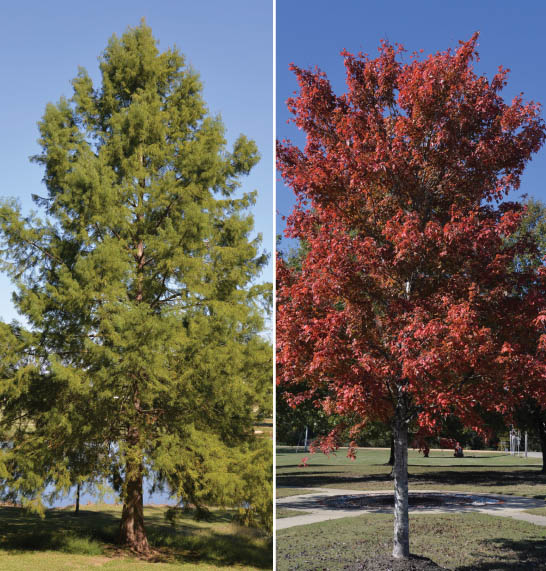
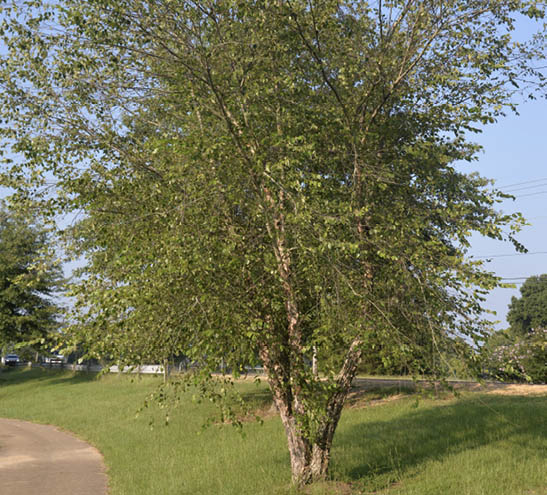
Many people believe if a tree is not dead, then it’s okay. Sadly, this is not necessarily true. Living trees require regular care and maintenance to remain healthy. Trees are rooted in place and cannot visit the doctor when they are sick. Trees cannot “speak” to us about what is bothering them. So, diagnosing tree health problems requires that we become detectives. We must observe what is happening to the tree and determine if it is a normal part of the tree’s life cycle or detrimental to the tree’s overall health.
Tree Defects
With this in mind, let’s don our detective’s cap and begin to assess tree health. Start by walking completely around the tree while examining the roots, trunk, and branches. Look for abnormalities or defects. Over 80 percent of trees that fail during storms have defects. Learning to identify tree defects is paramount to proper tree maintenance and risk management. Tree defects include cracks, decayed wood, weak branch unions, cankers, root problems, poor tree architecture, and dead trees, tops, or branches.
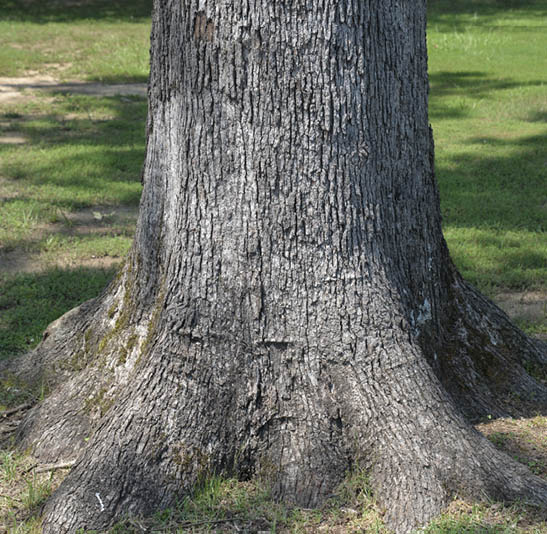
Cracks
Cracks are more than just splits in the bark. They typically go through the bark and into the wood of the tree. Cracks are signs that the load is exceeding the capacity of the wood to support the tree or branch. Shear cracks are vertical with the grain of the wood (Figure 4, left). Ribbed cracks occur as the tree tries to grow over a vertical crack. Tree movement or cold temperatures re-open the crack, so the tree grows a mound along the crack. Inrolled cracks occur as wood grows over a cavity (Figure 4, right). However, included bark prevents the wound from healing completely. Instead, the crack is perpetuated and enlarges. Horizontal cracks occur across the grain, indicating that wood fibers are pulling apart.
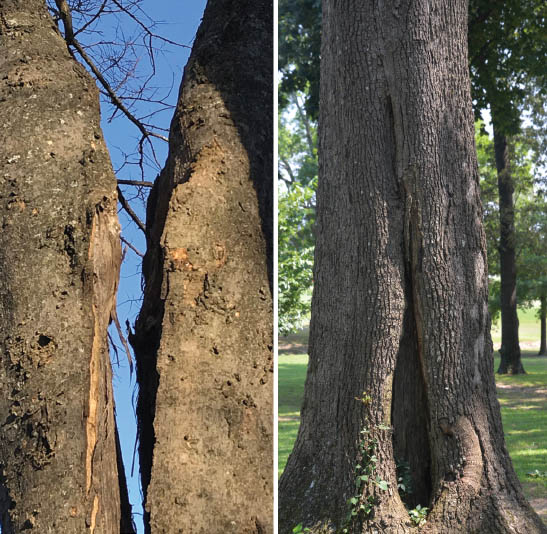
Trees with cracks have a moderate risk for failure. If the crack is splitting, or if there are multiple cracks or decay, then the tree has a high risk for failure. Any large branch (> 4 in diameter) with a crack has a high risk for failure.
Decayed Wood
Decayed wood is the result of a long-term interaction of fungi with the wood of the tree. Decay begins with a wound in the tree from injury, insects, or disease. The decomposition process progresses through several stages from stain, to rot, to a cavity. Signs of decomposition may be revealed in different ways. Loose bark is an indication that the wood underneath is dead. Fruiting bodies on the tree (Figure 5) reveal advanced decay that is active within the tree. When present, mushrooms or conks enable identification of the decay or disease fungus. Meanwhile, an open crack or cavity might reveal decayed wood or a completely hollow tree (Figure 6).
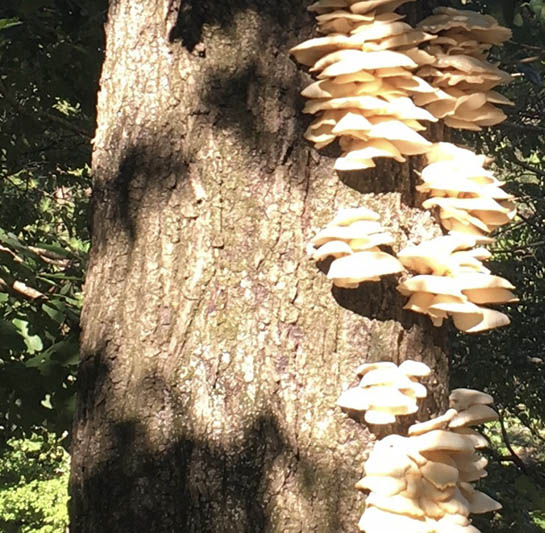
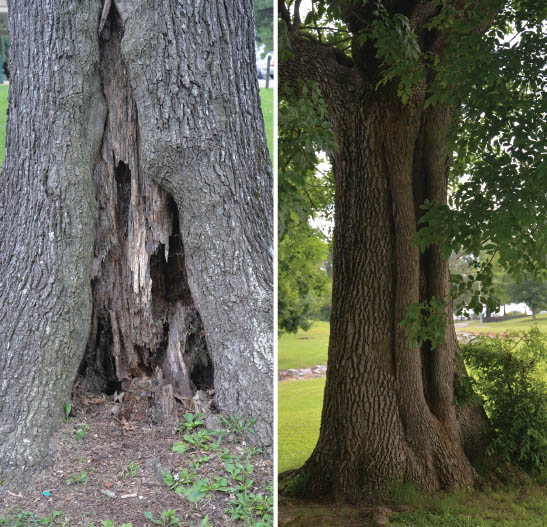
Decay within trees seriously weakens their structural integrity. Depending on the decay fungi, wood around a hollow or cavity may grow thicker, creating a bulge or swelling of the trunk (Figure 6, right). Generally, a hollow trunk needs one-third its thickness in structurally sound wood to support itself. If there is an opening into the tree (a cavity) then the trunk needs two-thirds its thickness in sound wood to support itself. Less sound wood than stated means the tree is a high risk for failure.
Evidence of decay across 25 - 40 percent of the trunk or root collar circumference has a moderate risk for failure. Greater than 40 percent decay across the circumference has a high risk for failure. A cavity extending greater than 30 percent of the circumference of the trunk has a high risk for failure. Also, any large branch (> 4 in diameter) with decay has a high risk for failure.
Weak Branch Unions
Different tree species have different wood properties. Several common types of trees in Mississippi are more prone to branch failure due to weak joints or brittle wood. Such trees include ashes, basswood, birches, black locust, cottonwood, elms, maples, pears, pines, or sugarberry. These trees should be planted away from driveways, roads, and structures. Mississippi State University Extension has publications for your consideration when planting trees, listed under ‘Additional Reading’ at the end.
Weak branch unions can also occur when branches or stems have bark between them. For instance, with co-dominant stems, two or more stems of comparable size occur in the tree, resulting in a multi-stemmed tree. As co-dominant stems grow, they may squeeze each other (Figure 7). This squeezed union is weak due to the included bark. Moreover, as the stems move in wind they rub and may create a wound, leading to decay which further weakens the tree.
Epicormic branches grow from buds beneath the bark. These buds are released to grow when the tree is stressed. Since the wood of the epicormic branch originates in the outer growth rings rather than from the center of the branch, these branch unions are weaker (Figure 7). Epicormic branches grow quickly and may sometimes fail under their own weight.
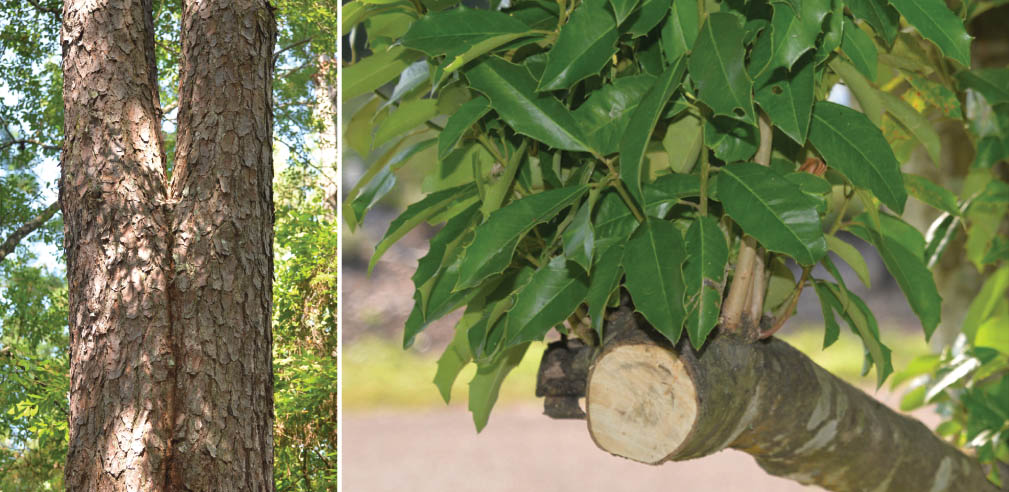
Cankers
Cankers may be caused by injury, insects, or disease in branches or the trunk. Once started, canker disease infects wood in each new growth ring, deforming and weakening the branch or stem as it spreads. Consequently, sound wood cannot cover the wound. This is especially troublesome when the canker occurs on the main stem (Figure 8).
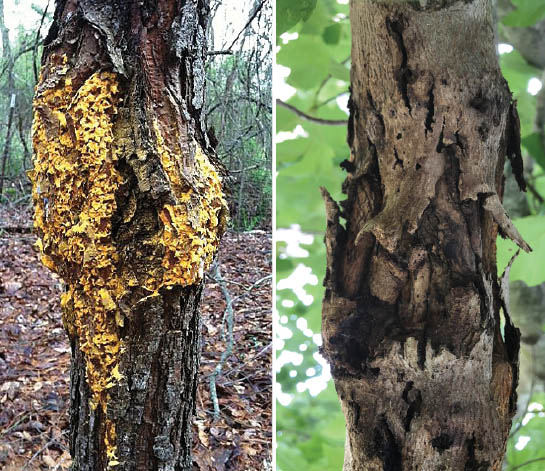
Cankers can make the trunk or branch more prone to failure in wind at the site of infection. Trees with a canker plus associated decay across 25 - 40 percent of the tree circumference have a moderate risk for failure. Cankers covering greater than 40 percent of the tree circumference indicate a high risk for failure.
Root Problems
Where the tree trunk meets the roots is known as the root collar. Usually, there is a flare at the base of the trunk where the structural roots radiate away from the tree (Figure 3). Occasionally, a tree might not show a flare at its root collar. Usually, this is observed on trees which were planted too deeply (Figure 9, left). The tree might survive and grow, but there is a greater possibility for rot to develop in its roots. Applying too much mulch can have the same effect (Figure 9, right).
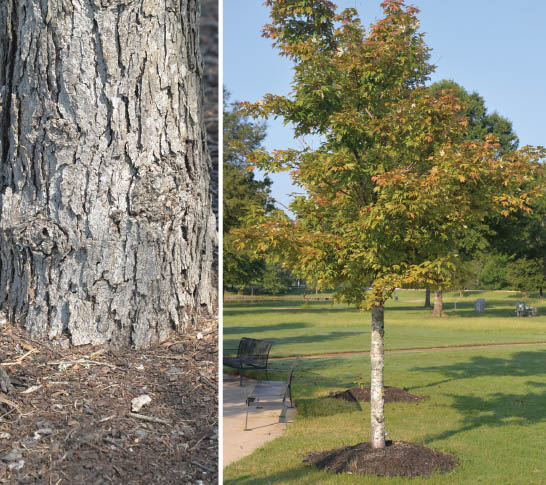
Crossing or circling roots is another common root problem. Tree roots grow in the direction they are pointing. Roots that circle the tree or cross roots will constrict other roots (Figure 10). Such roots may eventually impair water uptake and kill the tree. Girdling roots constricting more than 40 percent of the root collar circumference present a high risk for failure.
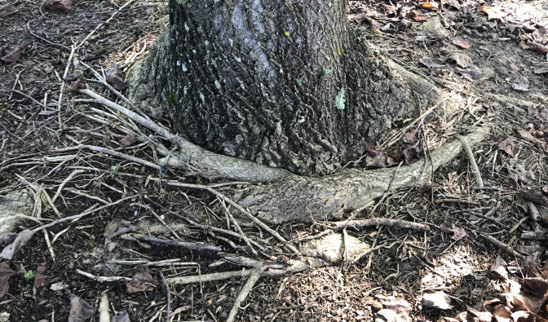
Some root problems are revealed by the health of the tree canopy. A healthy tree maintains its leafy canopy with healthy roots. If the tree suffers root loss from disease, injury, or soil compaction, there is a consequent reduction in leaf area as branches dieback. This is known as canopy decline (Figure 11). Some tree species are more sensitive to root damage or soil compaction. These species include American hornbeam, basswood, black cherry, black oak, black walnut, Eastern hophornbeam, pin oak, and white oak. Moderate crown dieback (about 30 percent in pine or 50 percent in hardwoods) indicates a moderate risk for failure. Without intervention, canopy decline continues until the tree dies.
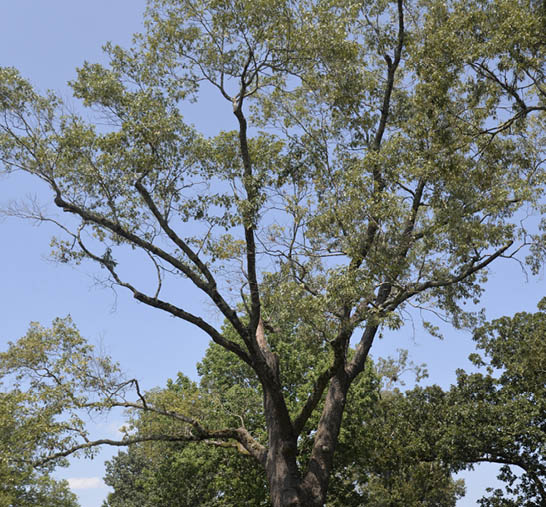
Just as with tree trunks and branches, the presence of mushrooms or conks on the root collar indicates decay or disease (Figure 12). Fungal fruiting bodies, when present, usually indicate advanced decay or infection in the root system. Decay across 25 to 40 percent of the root collar circumference indicates a moderate risk of failure.
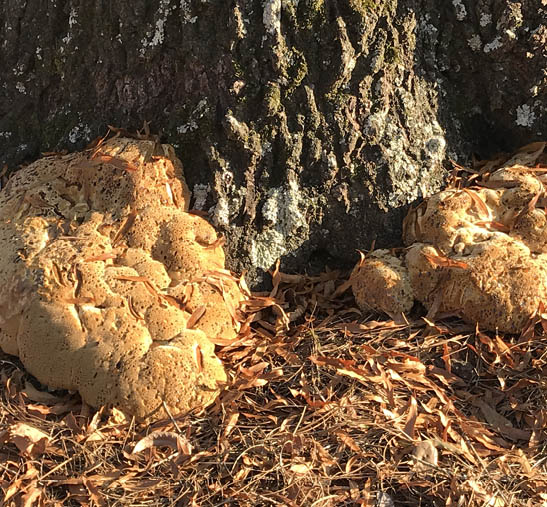
The structural roots forming the root plate can be damaged by mowers or string trimmers (Figure 13, left). The greatest stress on roots supporting a tree is above the soil line, which is where mowers or trimmers cause damage. It is best to mulch around trees (Figure 13, right) to keep traffic and equipment away from the root plate.
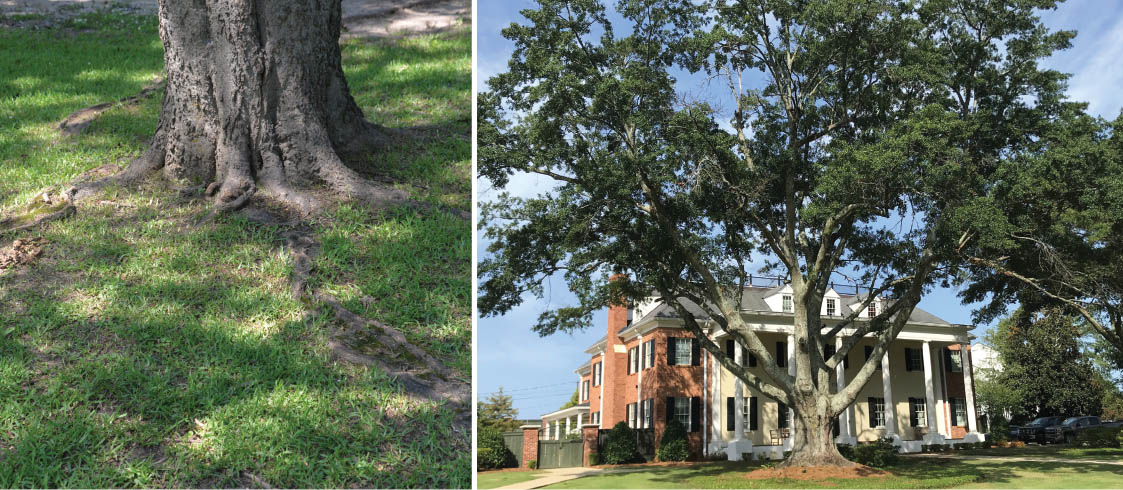
Finally, root damage from construction (cutting roots and/or soil compaction) causes defect. The critical root area around a tree is determined by a circle having a radius of 1.5 ft for every inch of diameter measured at breast height (4.5 ft above the ground). This area is usually beyond the drip line of the tree canopy. When construction projects are planned, the critical root area for protected trees should be marked with temporary fencing. No traffic of any sort should go into the critical root zone, and construction contracts should specify this. Root damage beyond 40 percent of the critical root area presents a high risk for tree failure.
Poor Tree Architecture
Although a tree trunk should grow plumb with the earth, such is not always the case. A leaning tree (15-40 degrees from plumb) is more prone to failure (Figure 14, left). There are other signs of failure in a leaning tree. A horizontal crack may form opposite the tree lean. Bulges in the bark and wood may form in the side of the lean as the tree buckles. In addition, a leaning tree may exhibit soil failure, whereby the root-ball starts to rise out of the ground, creating a mound of soil opposite the lean (Figure 14, right). Trees with excessive lean (> 40 degrees from plumb), or a lean with other defects such as cracks, decay, or soil mounding have a high risk for failure.
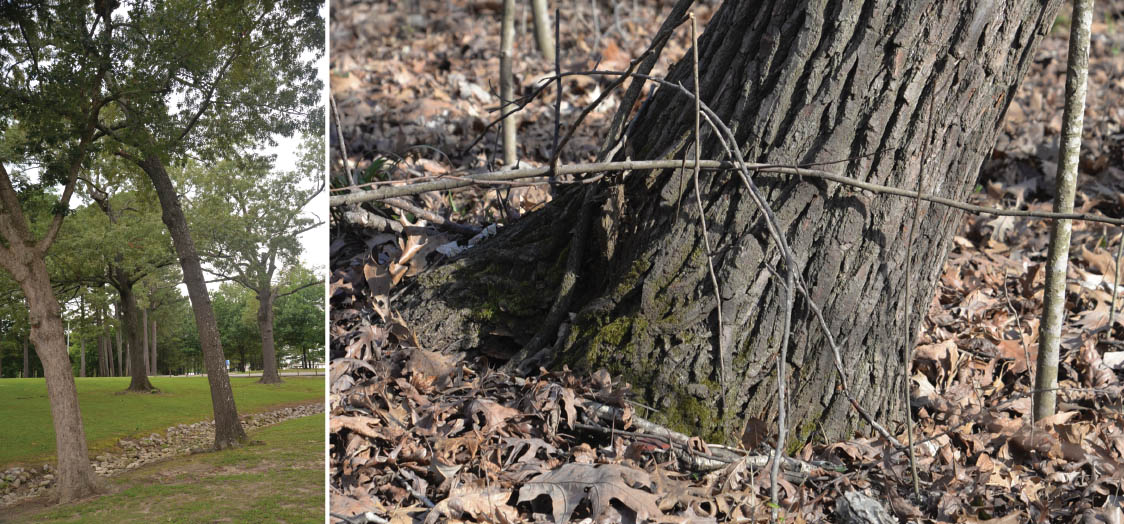
An unbalanced crown is another example of poor tree architecture. Often, storm-damaged trees loose significant portions of their canopy (Figure 15). This substantial loss of canopy decreases the ability of the tree to grow. Such loss of canopy can put a tree into decline. Also, lopsided trees are at a continued risk of failure, especially when their remaining canopy is caught in strong winds.
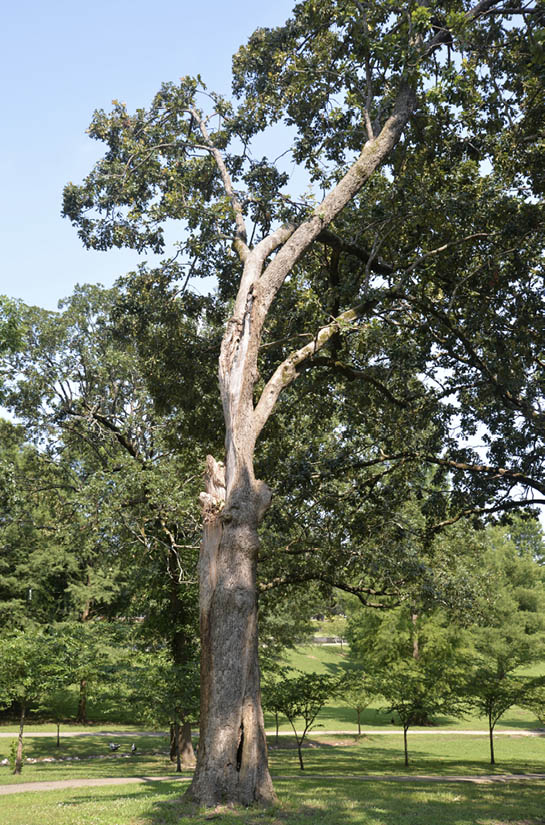
Dead Trees, Tops, and Branches
As trees mature, it is natural for branches to die as they become shaded. Decay fungi begin working once a tree has died, eventually destroying the structural integrity of the wood. The decay process works quickly in warm, humid climates. Therefore, dead wood is a high risk for hazard (Figure 16). Furthermore, cracked or hanging branches could fall at any time. These situations require immediate attention to mitigate risk. Regular maintenance is required to keep wooded areas safe by removing dead trees and branches.
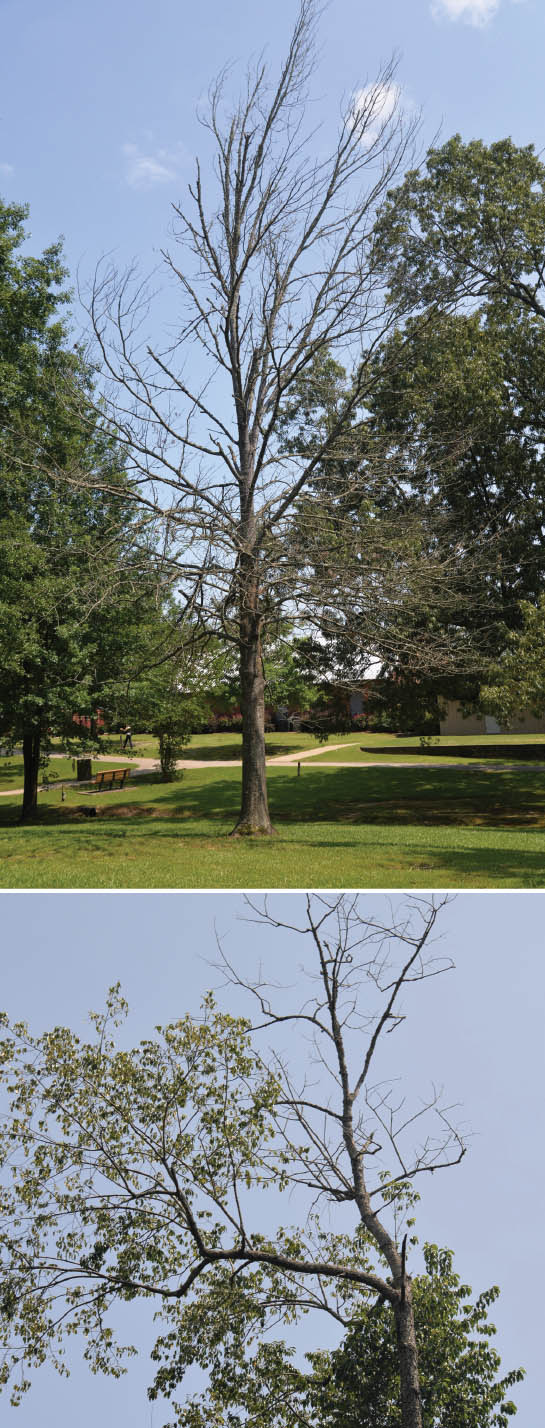
Risk Management
Hazardous Trees
Not every tree with defects is hazardous. When determining the risk of hazard, three things must be evaluated:
- Conduct a tree health assessment to find any defect(s). This evaluation is used to assess the risk for failure.
- Consider the size and weight of the tree or limb. Progressively higher risk is associated with larger branches or trees.
- Note the proximity of the tree to any potential target. Potential targets include people and/or property that might be struck if the tree or branch fell.
Tree defect(s), weight of affected part of the tree, and its likelihood to strike a target are the primary factors used to determine the risk of hazard.
Risk Assessment System
We can rank the overall risk of a potentially hazardous tree using the three components described. This is done by evaluating each hazard component of the tree, and then combining those individual ratings (see Risk Management System in the Appendix). Tables 1-3 summarize the risk assessment for each hazard component using a 4-point scale (Pokorny 2003). Table 1 provides a rating of risk for tree or limb failure. Each risk category includes a description of tree defects and their degree of development. Table 2 gives a risk rating based on the size and weight of a tree part. Small diameter limbs (< 4 inches in diameter) may weigh several hundred pounds, whereas large trees might weigh several tons. Table 3 furnishes a risk rating for the likelihood of a tree, limb or branch hitting a target. The higher the pedestrian use, vehicular traffic, or proximity of structures around the tree, the greater the risk for hitting a target.
Finally, Table 4 shows how to combine the risk hazards into an overall risk ranking. Although subjective, the risk ranking does provide a means toward prioritizing attention for intervention. Since they are subjective, risk ratings can be adjusted to reflect a higher ranking to prompt intervention.
Corrective Actions
Hazardous tree situations can be remediated by addressing and/or changing any one of the three components mentioned. Solutions will vary with the circumstances of each situation. In all cases, consideration for personal safety takes precedence.
Sometimes, removing the target might be an option. For instance, a hazard tree in an open park can be maintained by putting a fence around the tree to keep people away. If the hazard is from dead limbs, temporary fencing will protect people until pruning is done to remove the dead wood.
Removing the hazard is another option. Some defects can be mitigated to lessen the potential impact. Cracks or co-dominant stems could be braced with a bolt to reduce the risk of tree failure (Figure 17). Similarly, a leaning tree could be cabled to mitigate its risk of failure. Measures like bracing and cabling require periodic inspections by qualified arborists to maintain safety.
Pruning is an option to remove dead branches, or balance the canopy of a tree. Yet, not all tree defects can be mitigated easily. There will be many situations where removing the tree is the best option despite its higher cost.
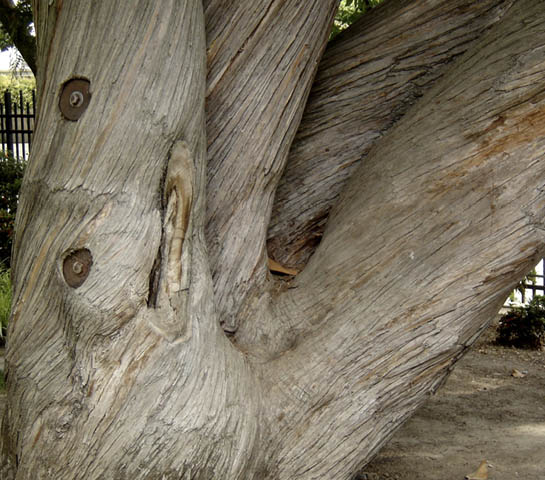
Preventive Actions
Many hazard tree situations can be avoided by having a proactive, individual or urban forestry program in place. This starts with planting the right tree in the right place. Site conditions (soil, moisture, sunlight, available space) should be matched with trees that prefer those specific conditions (Figure 18). Trees should be planted to the same depth as their root mass, with the root collar at ground level. This allows the root flare to be exposed to air and helps the tree avoid root disease.
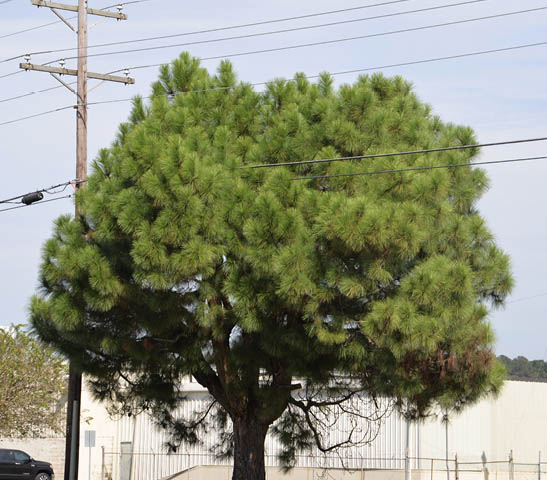
Maintaining trees with a regular pruning schedule is ideal, permitting them to grow with fewer defects. A co-dominant stem can be easily eliminated while the tree is young. Periodic pruning will also prevent branches from crossing, which may cause wounding and lead to decay. Furthermore, pruning small branches permits faster healing since the wounds are smaller.
Summary
Conducting a tree health assessment requires looking overall at the tree from the roots, up the trunk, and into the branches. Note all tree defects: cracks, decayed wood, weak branch unions, cankers, root problems, poor tree architecture, and dead trees, tops, or branches. Evaluating potential safety risks entails looking for potential targets to tree failure. Risks can be mitigated by removing the target or the hazard itself. Proper planning and regular maintenance can prevent many potential tree hazards from developing.
Additional Reading
Minnesota Dept Natural Resources and USDA Forest Service. (1996). How to Recognize Hazardous Defects in Trees. USDA Forest Service, NA-FR-01-96. 20p.
Pokorny, JD (ed). (2003). Urban Tree Risk Management: A Community Guide to Program Design and Implementation, NA-TP-03-03. USDA Forest Service, Northeastern Area State & Private Forestry, St. Paul, MN. 194p.
Risk Management System
Table 1. Likelihood of tree or limb failure
|
Risk Rating for Tree/Limb Failure |
Description |
|
1: Low |
A few, minor defects present:
|
|
2: Moderate |
Moderate defects present:
|
|
3: High |
Multiple or significant defects present:
|
|
4: Extreme |
Multiple or significant defects present:
|
Table 2. Risk from size of defective part
|
Risk Rating for Size |
Description |
|
1: Low |
Small: Stem or branch < 4 inches in diameter |
|
2: Moderate |
Medium: Stem or branch 4 – 16 inches diameter (500 lbs – 2 tons) |
|
3: High |
Large: Stem or branch 16 – 30 inches diameter (2 – 10 tons) |
|
4: Extreme |
Huge: Stem or branch > 30 inches diameter |
Table 3. Likelihood of hitting a target
|
Risk Rating for Hitting a Target |
Description |
|
1: Low |
Infrequent:
|
|
2: Moderate |
Intermediate:
|
|
3: High |
Frequent:
|
|
4: Extreme |
Additional Risk Factors beyond High:
|
Table 4. Combining risk rating from each hazard component for overall risk ranking
|
Overall Risk Ranking |
= Risk for Failure + Risk for Size + Risk for Hitting Target |
|
Low |
< 4 |
|
Moderate |
4 -- 6 |
|
High |
7 -- 9 |
|
Extreme |
> 9 |
Color photos by author unless noted otherwise.
Publication 3717 (POD-10-21)
By John D. Kushla, PhD, Extension/Research Professor, Professor of Forestry and ISA Certified Arborist, Co-coordinator for Urban Forestry plan of work in MSU Extension, and North Mississippi Research and Extension Center; and Jeff Wilson, PhD, Associate Professor of Extension, Plant and Soil Sciences.
The Mississippi State University Extension Service is working to ensure all web content is accessible to all users. If you need assistance accessing any of our content, please email the webteam or call 662-325-2262.





